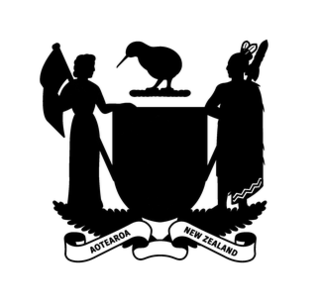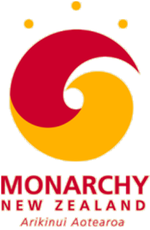
The monarchy of Canada is Canada's form of government embodied by the Canadian sovereign and head of state. It is one of the key components of Canadian sovereignty and sits at the core of Canada's constitutional federal structure and Westminster-style parliamentary democracy. The monarchy is the foundation of the executive (King-in-Council), legislative (King-in-Parliament), and judicial (King-on-the-Bench) branches of both federal and provincial jurisdictions. The current King of Canada is Charles III, who has reigned since 8 September 2022.

The Supreme Court of New Zealand is the highest court and the court of last resort of New Zealand. It formally came into being on 1 January 2004 and sat for the first time on 1 July 2004. It replaced the right of appeal to the Judicial Committee of the Privy Council, based in London. It was created with the passing of the Supreme Court Act 2003, on 15 October 2003. At the time, the creation of the Supreme Court and the abolition of appeals to the Privy Council were controversial constitutional changes in New Zealand. The Supreme Court Act 2003 was repealed on 1 March 2017 and superseded by the Senior Courts Act 2016.

Sir Peter Wilfred Tapsell was Speaker of the New Zealand House of Representatives from 1993 to 1996. He was notable for being the first Māori Speaker, and for being the first Speaker since Bill Barnard in 1943 to hold office while not a member of the governing party.

The monarchy of New Zealand is the constitutional system of government in which a hereditary monarch is the sovereign and head of state of New Zealand. The current monarch, King Charles III, acceded to the throne following the death of his mother, Queen Elizabeth II, on 8 September 2022 in the United Kingdom. The King's elder son, William, Prince of Wales, is the heir apparent.

The koru is a spiral shape based on the appearance of a new unfurling silver fern frond. It is an integral symbol in Māori art, carving and tattooing, where it symbolises new life, growth, strength and peace. Its shape "conveys the idea of perpetual movement," while the inner coil "suggests returning to the point of origin".

The New Zealand Film Commission is a New Zealand government agency formed to assist with creating and promoting New Zealand films. It was established under the New Zealand Film Commission Act 1978.
Ian Murray Revell is a former New Zealand politician. He was an MP from 1990 to 1999, representing the National Party. Before entering politics, Revell was a senior detective in the New Zealand Police.

New Zealand Republic Inc. is an organisation formed in 1994 whose object is to support the creation of a New Zealand republic.

Republicanism in New Zealand is the political position that New Zealand's system of government should be changed from a constitutional monarchy to a republic.

The Monarchist League of Canada is a Canadian nonprofit monarchist advocacy organization. This league promotes its aims in three areas: education, advocacy, and research. Local branches and many under the patronage of lieutenant governors, complement these areas of focus by acting as a grassroots rallying point for members.

The Republic of New Zealand Party is an unregistered New Zealand political party which seeks to end monarchy in New Zealand. It was a registered party from 2005 to 2009, contesting two general elections in that time and each time receiving the lowest share of the party vote. After deregistration, some members continued in politics under the party name, though since at least 2011 only one person, Jack Gielen, has contested elections under the name.

New Zealand Herald of Arms Extraordinary is the officer of arms responsible for the regulation of heraldry in New Zealand. Although affiliated with the College of Arms in London, the New Zealand Herald lives and works in New Zealand, and is not a member of the College Chapter. The current New Zealand Herald of Arms Extraordinary is Phillip Patrick O'Shea.

The Australian Monarchist League (AML) is an incorporated nonprofit organisation, that runs throughout Australia, promoting and educating on the Australian Constitution and monarchy. The organisation was part of the successful "no" campaign in the 1999 republic referendum, which asked whether Australia should become a republic and whether Australia should alter the constitution to insert a preamble. Neither of the amendments passed.

Canadian monarchism is a movement for raising awareness of Canada's constitutional monarchy among the Canadian public, and advocating for its retention, countering republican and anti-monarchical reform as being generally revisionist, idealistic, and ultimately impracticable. Generally, Canadian monarchism runs counter to anti-monarchist republicanism, but not necessarily to the classical form of republicanism itself, as most monarchists in Canada support the constitutional variety of monarchy, sometimes referred to as a crowned republic. These beliefs can be expressed either individually—generally in academic circles—or through what are known as loyal societies, which include the Monarchist League of Canada, legions, historical groups, ethnic organizations, and sometimes police and scout bodies. Though there may be overlap, this concept should not be confused with royalism, the support of a particular monarch or dynasty; Canadian monarchists may appreciate the monarchy without thinking highly of the monarch. There have also been, from time to time, suggestions in favour of a uniquely Canadian monarch, either one headed by a descendant of the present monarch and resident in Canada or one based on a First Nations royal house.

The governor-general of New Zealand is the viceregal representative of the monarch of New Zealand, currently King Charles III. As the King is concurrently the monarch of 14 other Commonwealth realms and lives in the United Kingdom, he, on the advice of his New Zealand prime minister, appoints a governor-general to carry out his constitutional and ceremonial duties within the Realm of New Zealand.

Tūheitia Potatau Te Wherowhero VII, crowned as Kīngi Tūheitia, is the Māori King. He is the eldest son of the previous Māori monarch, Te Arikinui Dame Te Atairangikaahu, and was announced as her successor and crowned on 21 August 2006, the day her tangihanga took place.

By the arrangements of the Canadian federation, the Canadian monarchy operates in Saskatchewan as the core of the province's Westminster-style parliamentary democracy. As such, the Crown within Saskatchewan's jurisdiction is referred to as the Crown in right of Saskatchewan, His Majesty in right of Saskatchewan, or His Majesty the King in right of Saskatchewan. The Constitution Act, 1867, however, leaves many royal duties in Saskatchewan specifically assigned to the sovereign's viceroy, the Lieutenant Governor of Saskatchewan, whose direct participation in governance is limited by the conventional stipulations of constitutional monarchy.

By the arrangements of the Canadian federation, Canada's monarchy operates in British Columbia as the core of the province's Westminster-style parliamentary democracy. As such, the Crown within British Columbia's jurisdiction is referred to as the Crown in Right of British Columbia, His Majesty in Right of British Columbia, or the King in Right of British Columbia. The Constitution Act, 1867, however, leaves many royal duties in British Columbia specifically assigned to the sovereign's viceroy, the Lieutenant Governor of British Columbia, whose direct participation in governance is limited by the conventional stipulations of constitutional monarchy.

By the arrangements of the Canadian federation, Canada's monarchy operates in Alberta as the core of the province's Westminster-style parliamentary democracy. As such, the Crown within Alberta's jurisdiction is referred to as the Crown in Right of Alberta, His Majesty in Right of Alberta, or The King in Right of Alberta. The Constitution Act, 1867, however, leaves many royal duties in Alberta specifically assigned to the sovereign's viceroy, the Lieutenant Governor of Alberta, whose direct participation in governance is limited by the conventional stipulations of constitutional monarchy.

The monarchy of Canada forms the core of each Canadian provincial jurisdiction's Westminster-style parliamentary democracy, being the foundation of the executive, legislative, and judicial branches of government in each province. The monarchy has been headed since September 8, 2022 by King Charles III who as sovereign is shared equally with both the Commonwealth realms and the Canadian federal entity. He, his consort, and other members of the Canadian royal family undertake various public and private functions across the country. He is the only member of the royal family with any constitutional role.


















